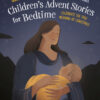In Sara’s Surprise, a Bûche de Noël cake became a special Yule Log wedding cake. For Sara, it was the perfect cake for her Christmas wedding. But where did the Yule Log tradition come from?
The custom of the Yule Log goes back to before medieval times. It was originally based on the Nordic tradition of Yule, a Winter Solstice festival. Burning the Yule Log was one of the most widespread Christmas traditions in early modern Europe, with the first recording of its appearance dating to 1184. For the Christian feast of Christmas, the Yule Log symbolizes the battle between good and evil. “As the fire grows brighter and burns hotter, and as the log turned into ashes, it symbolized Christ’s final and ultimate triumph over sin.”
The traditional Yule Log was originally an entire tree carefully chosen and brought into the house with great ceremony. The largest end of the log would be placed into the fire hearth while the rest of the tree stuck out into the room. The log would be lit from the remains of the previous year’s log that was carefully stored away. Then, the Yule Log was slowly burned throughout the Twelve Days of Christmas.
As Christianity spread through Europe, the Yule Log tradition became part of Christmas Eve festivities. The father or master of the house would sprinkle the log with libations of mead, oil, or salt. Once the log was burned in the hearth, the ashes were scattered about the house to protect the family within from evil spirits. On Christmas morning something green, a leaf or the like, was brought into the house before anything was taken out. A piece of the Yule Log was then saved to light the next year’s log.
In Provence, France, the whole family helps to cut the log down and a little bit is burnt each night. In the Netherlands, the leftover log is stored under a bed. In some eastern European countries, the log was cut down on Christmas Eve morning and lit that evening.
The custom of the Yule Log spread all over Europe and different kinds of wood are used in different countries. In England, oak is traditional; in Scotland, birch; in France, cherry wood is sprinkled with wine before it’s burned so it smells nice.
In Devon and Somerset in the UK, some people use ash twigs instead of a log. This comes from a local legend that Joseph, Mary, and Jesus were cold when the shepherds found them on Christmas Night. So the shepherds collected twigs to burn and keep them warm. In Ireland they use a large candle instead of a log that’s lit on New Year’s Eve and Twelfth Night.
In France, the Yule Log is bûche de noel where a custom required that peasants to bring a log to their lord. In Burgundy, gifts were hidden under the log. In Brittany and in Provence prayers were offered as the log was lit, a custom still widely observed called cacho fio (blessing of the log). The eldest male parades the log around the house three times. Then it’s blessed with wine and lit with the ashes of the previous year’s log.

 Susan G. Mathis is vice president of Christian Authors Network and a multi-published author of stories set in the beautiful Thousand Islands, her childhood stomping ground in upstate NY. Katelyn’s Choice, the first in The Thousand Islands Gilded Age series, is available now, and book two, Devyn’s Dilemma, releases in April, 2020. Learn more about The Fabric of Hope: An Irish Family Legacy, Christmas Charity, and Sara’s Surprise at www.SusanGMathis.com. Susan is also author of two premarital books with her husband, Dale; two children’s picture books; stories in a dozen compilations; and hundreds of articles. Susan lives in Colorado Springs and enjoys traveling globally and Skyping with her four granddaughters.
Susan G. Mathis is vice president of Christian Authors Network and a multi-published author of stories set in the beautiful Thousand Islands, her childhood stomping ground in upstate NY. Katelyn’s Choice, the first in The Thousand Islands Gilded Age series, is available now, and book two, Devyn’s Dilemma, releases in April, 2020. Learn more about The Fabric of Hope: An Irish Family Legacy, Christmas Charity, and Sara’s Surprise at www.SusanGMathis.com. Susan is also author of two premarital books with her husband, Dale; two children’s picture books; stories in a dozen compilations; and hundreds of articles. Susan lives in Colorado Springs and enjoys traveling globally and Skyping with her four granddaughters.
Facebook: https://www.facebook.com/SusanGMathis
Twitter: https://twitter.com/@SusanGMathis
Instagram: https://www.instagram.com/susangmathis
Pinterest: https://www.pinterest.com/susangmathisaut
Goodreads: https://www.goodreads.com/author/show/6044608.Susan_G_Mathis


